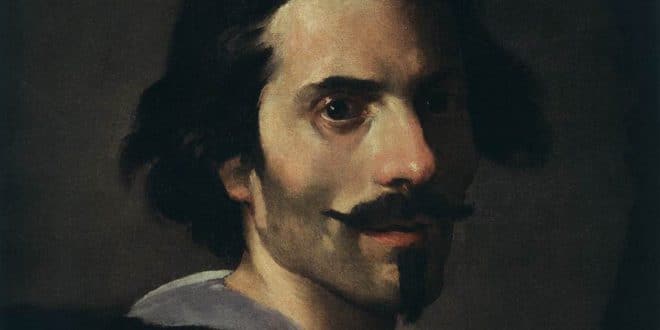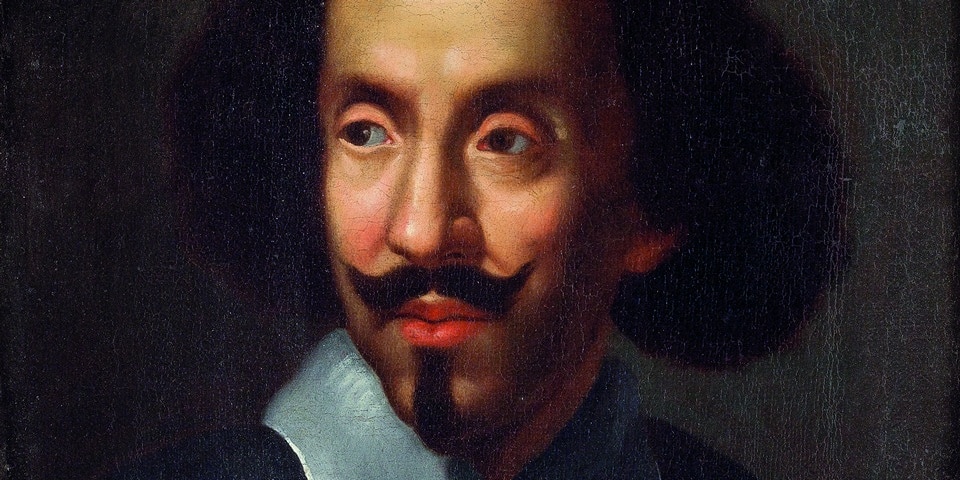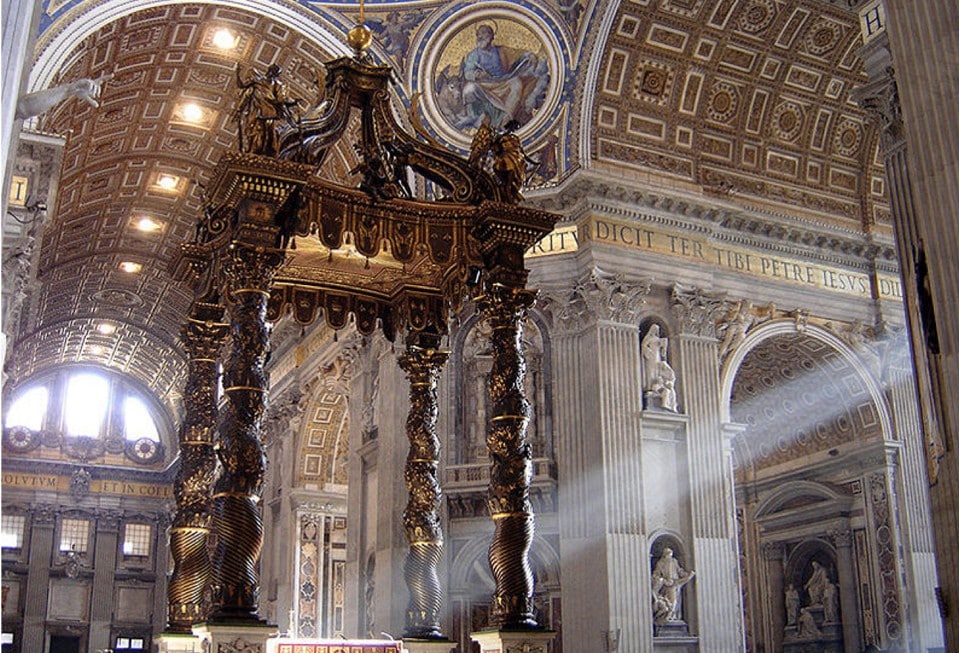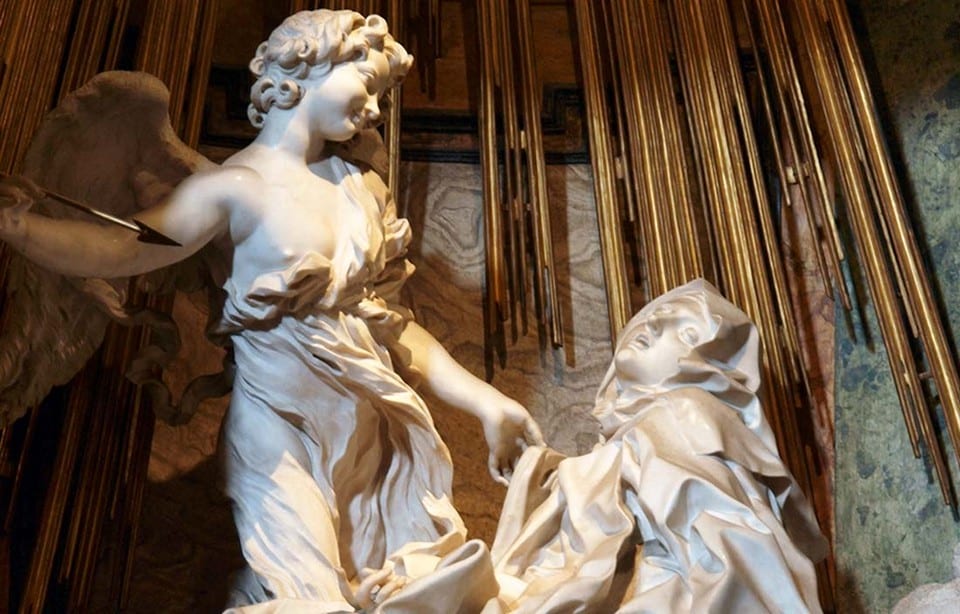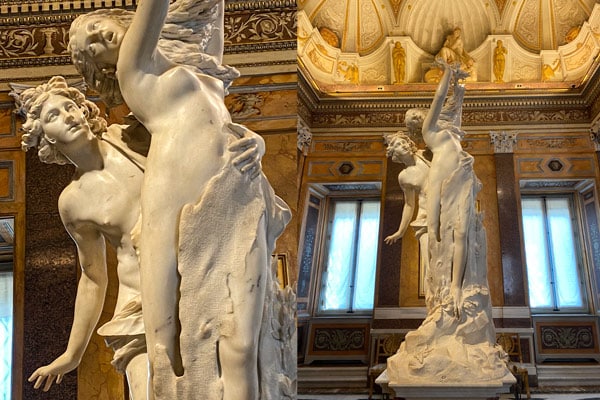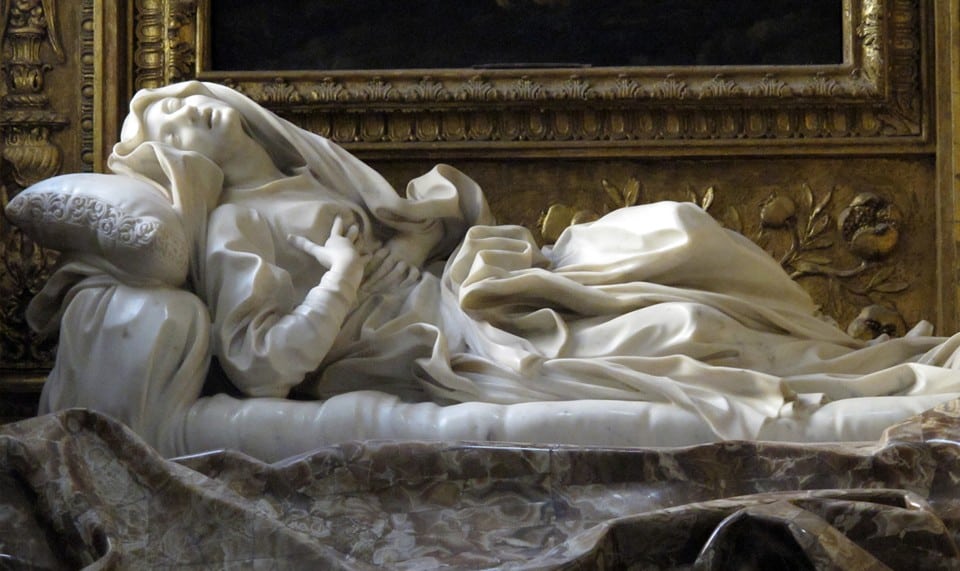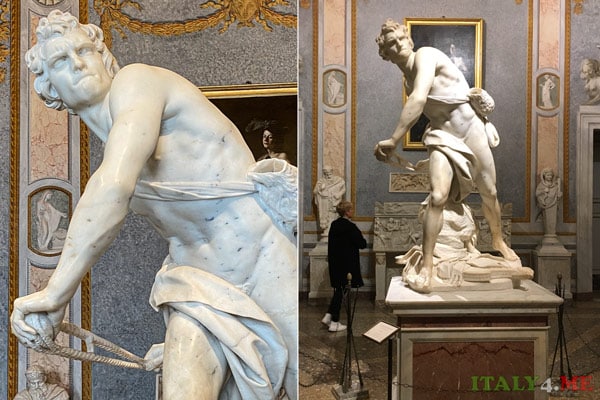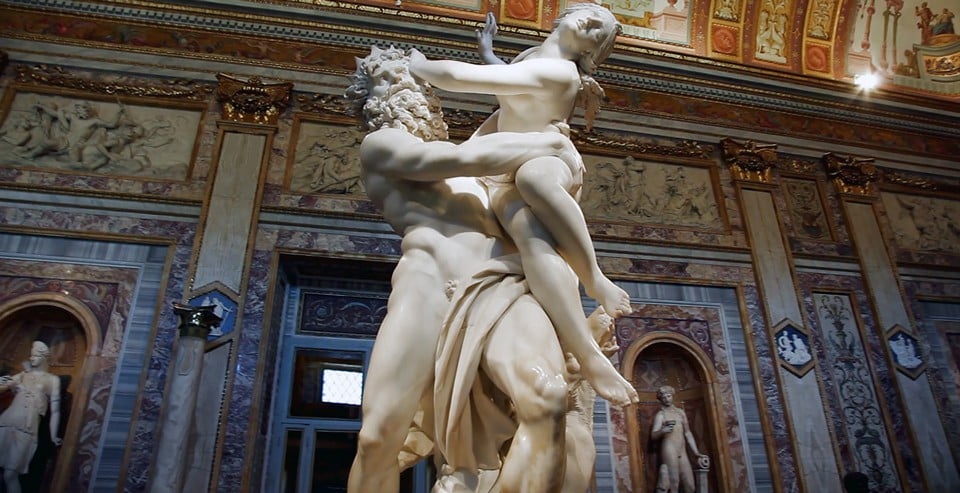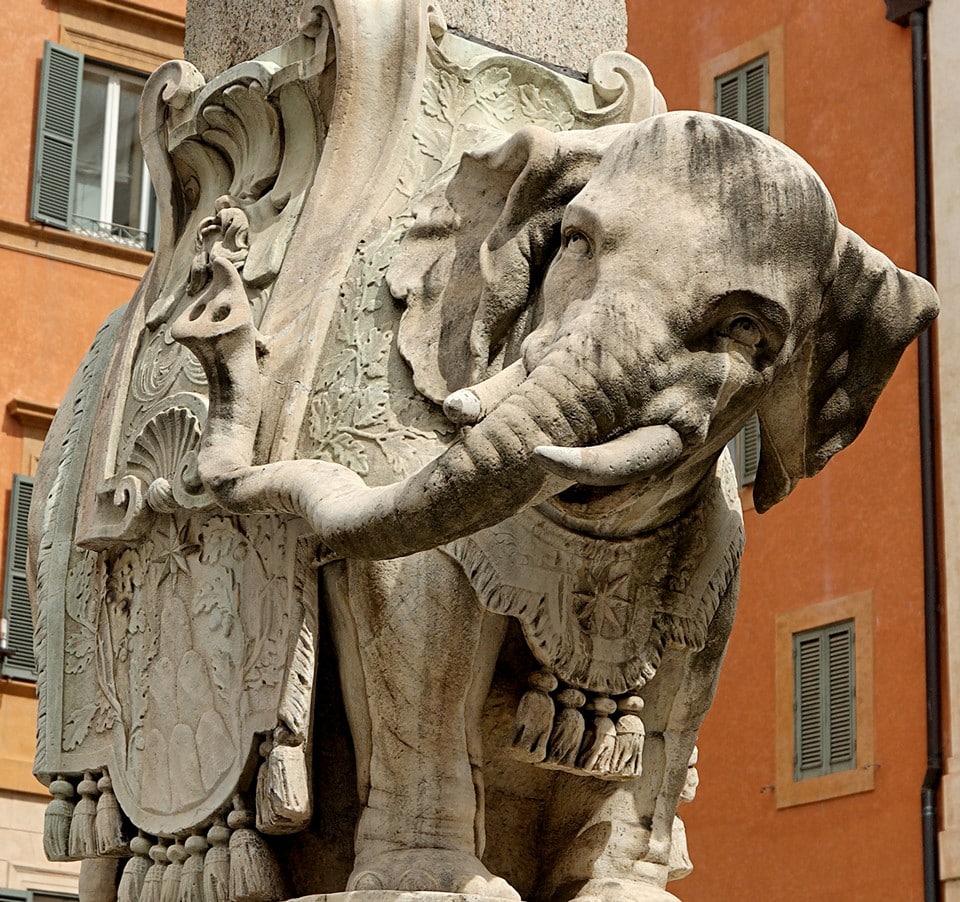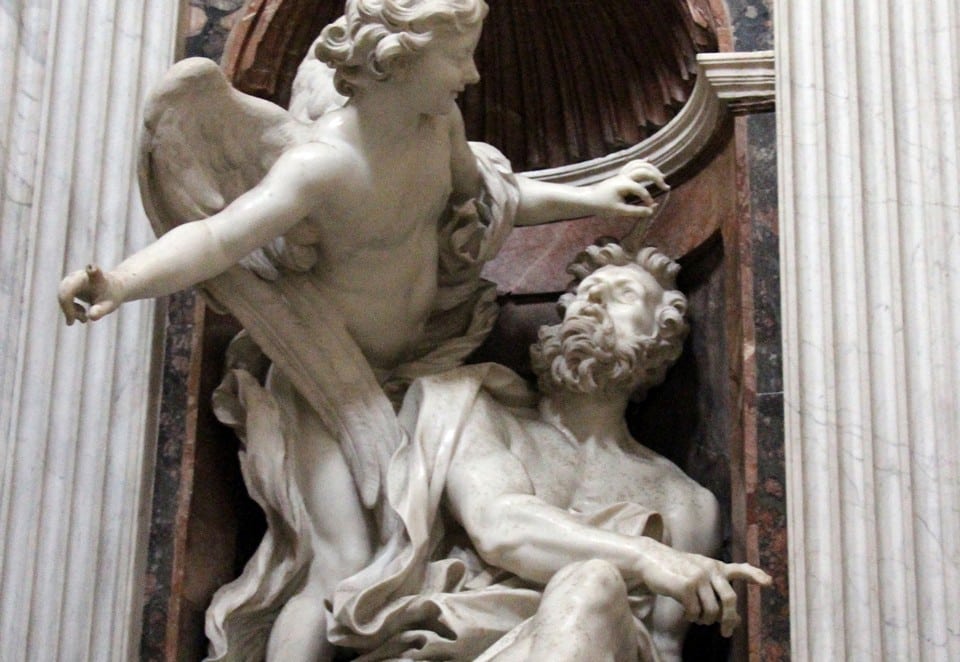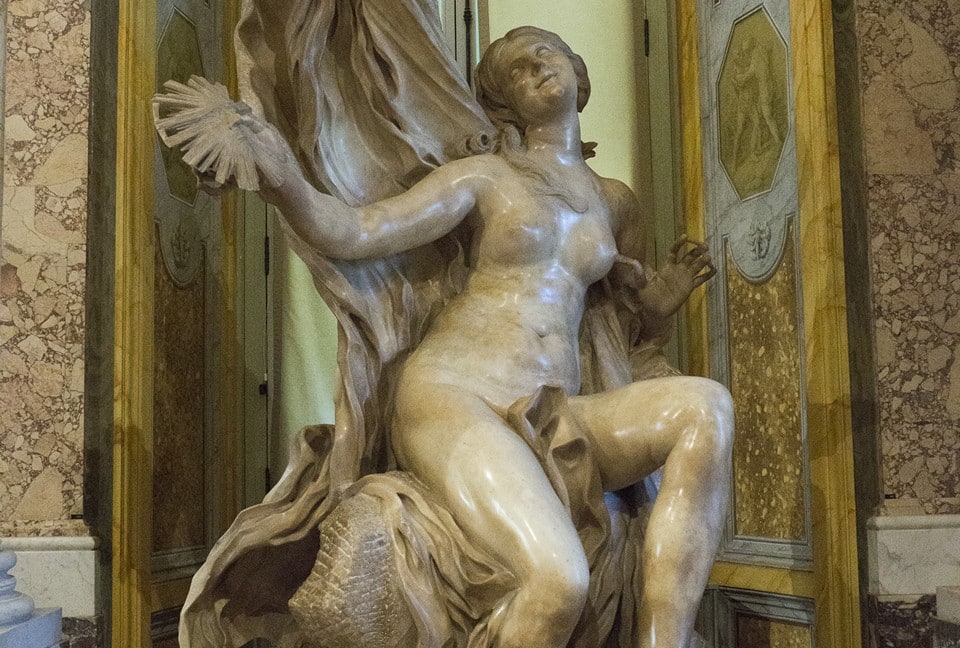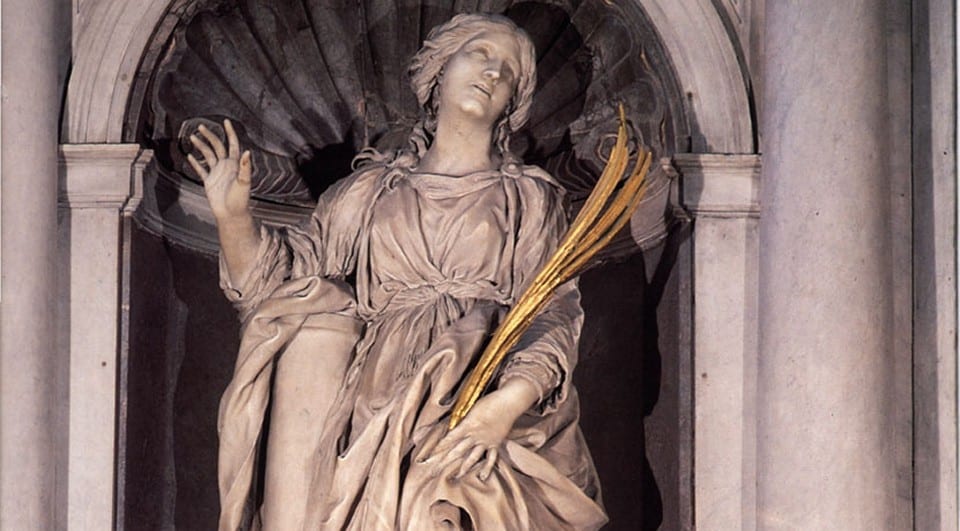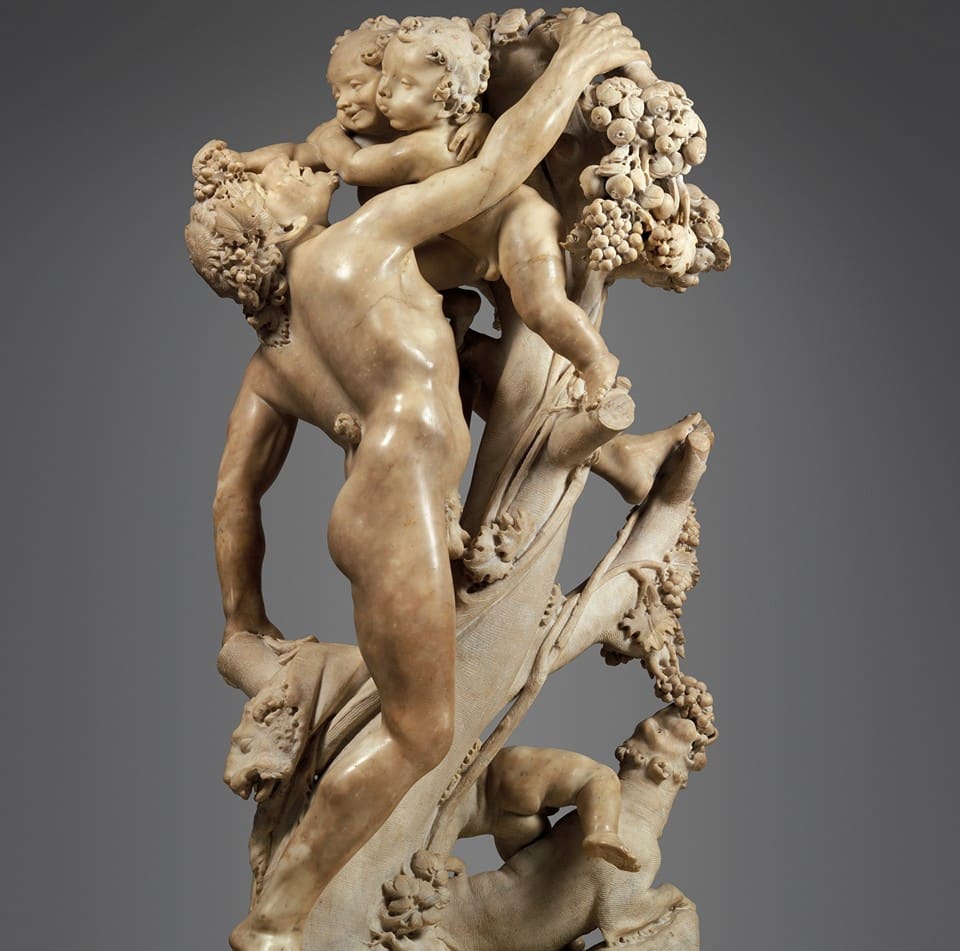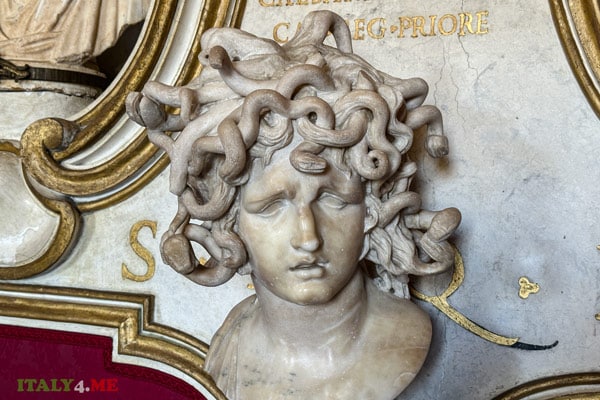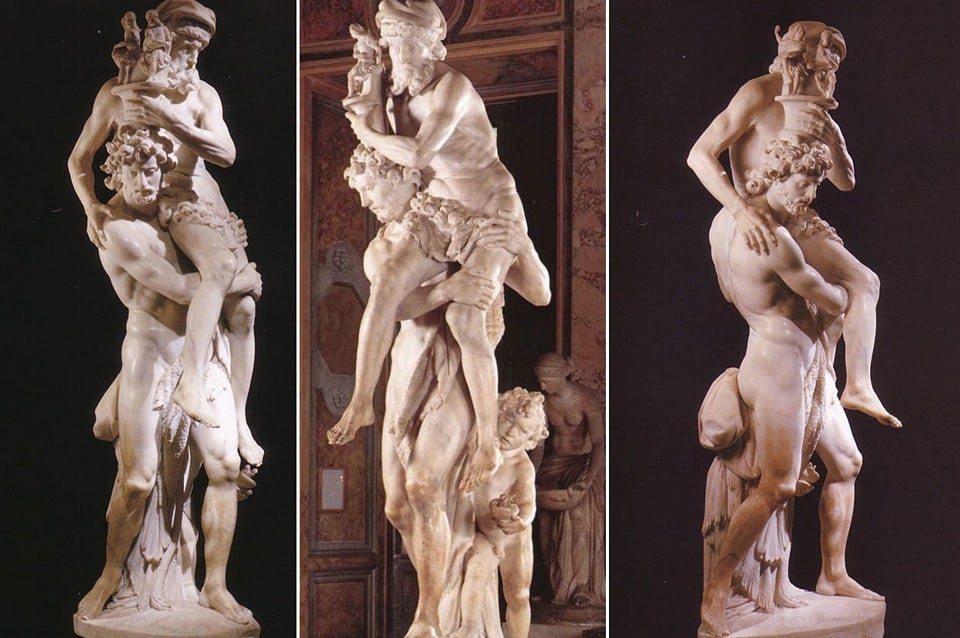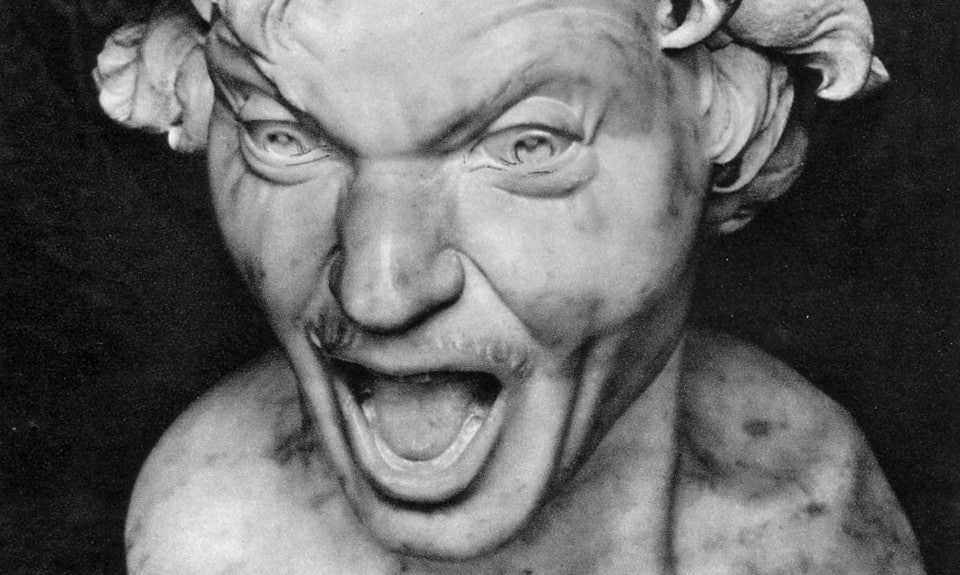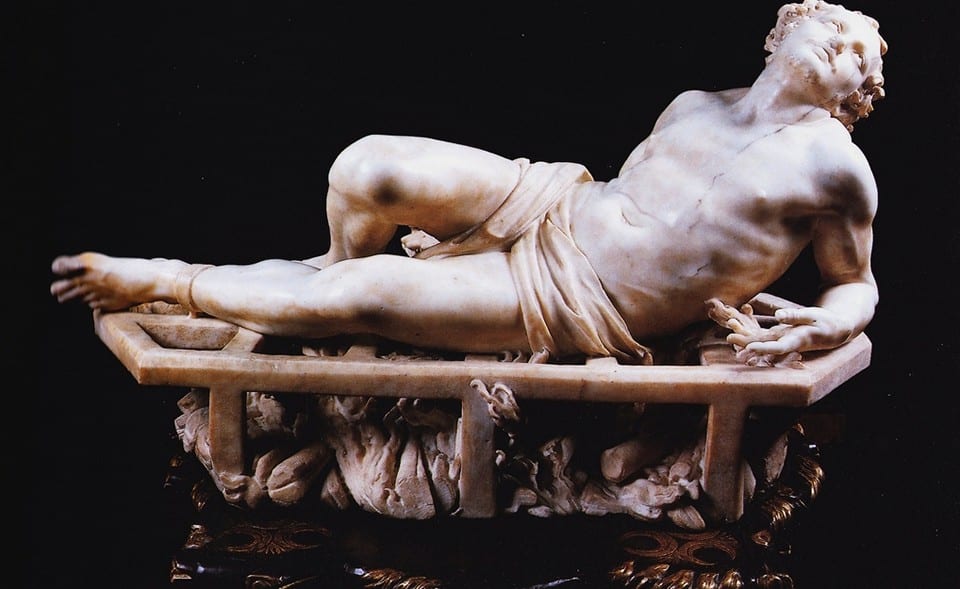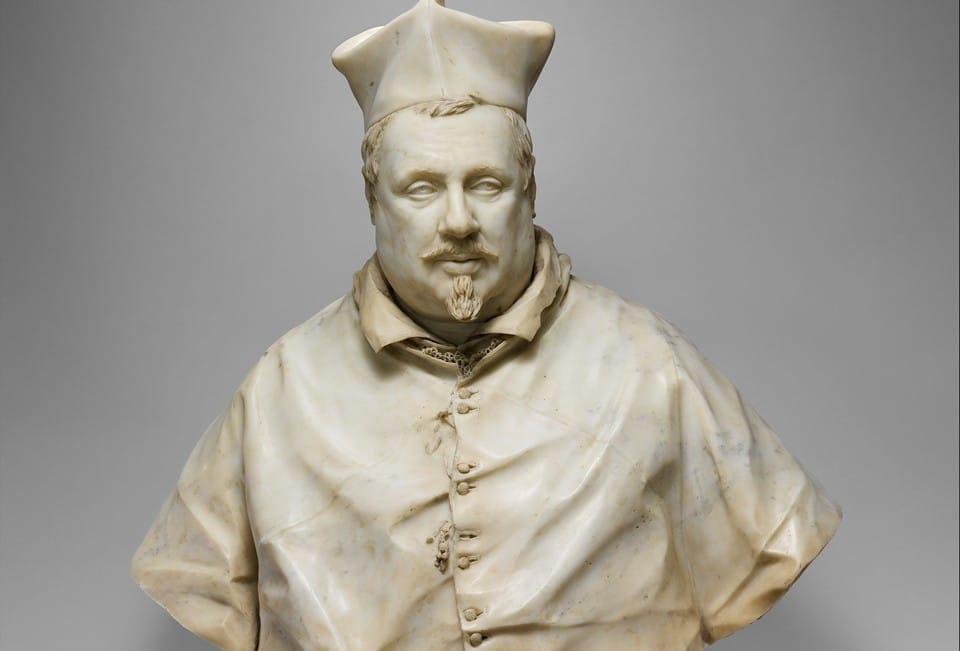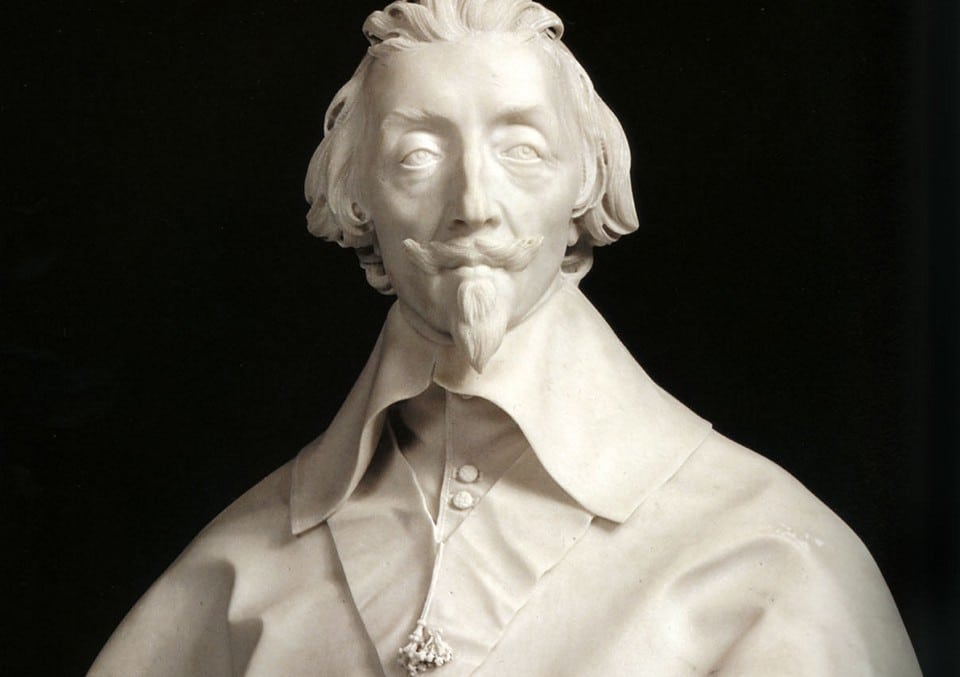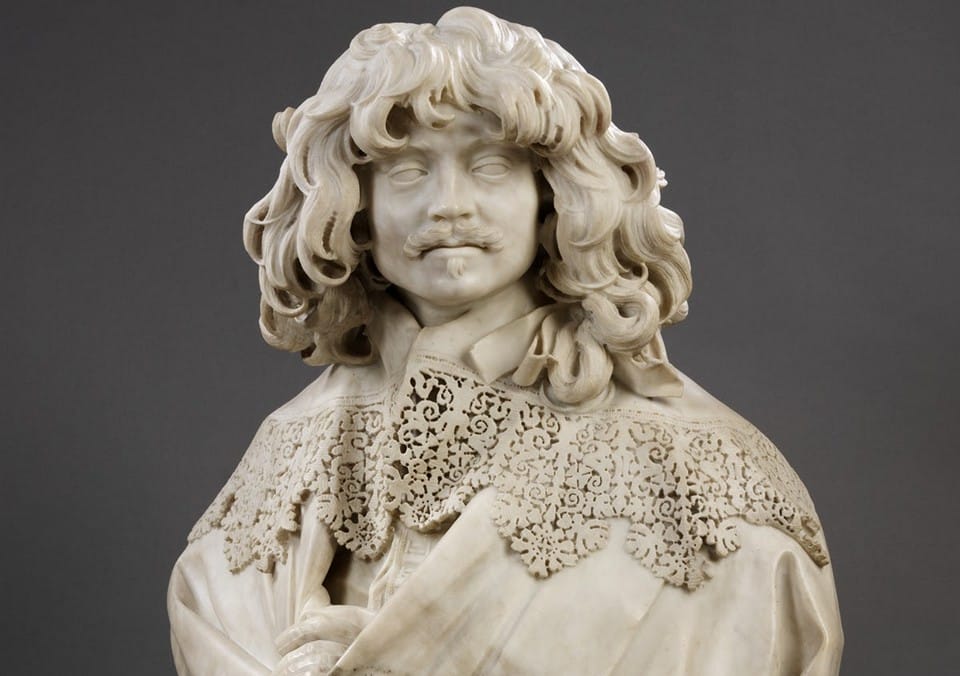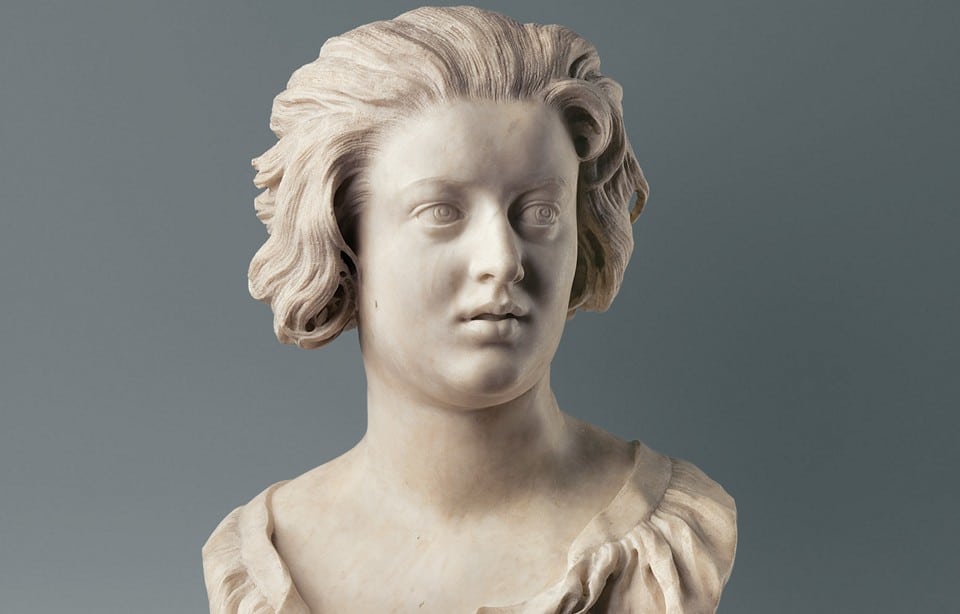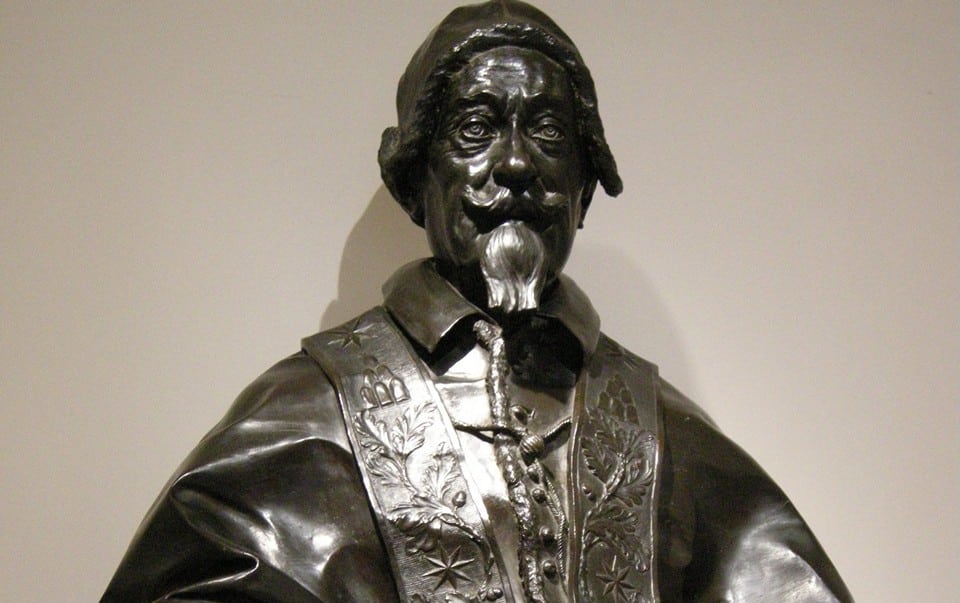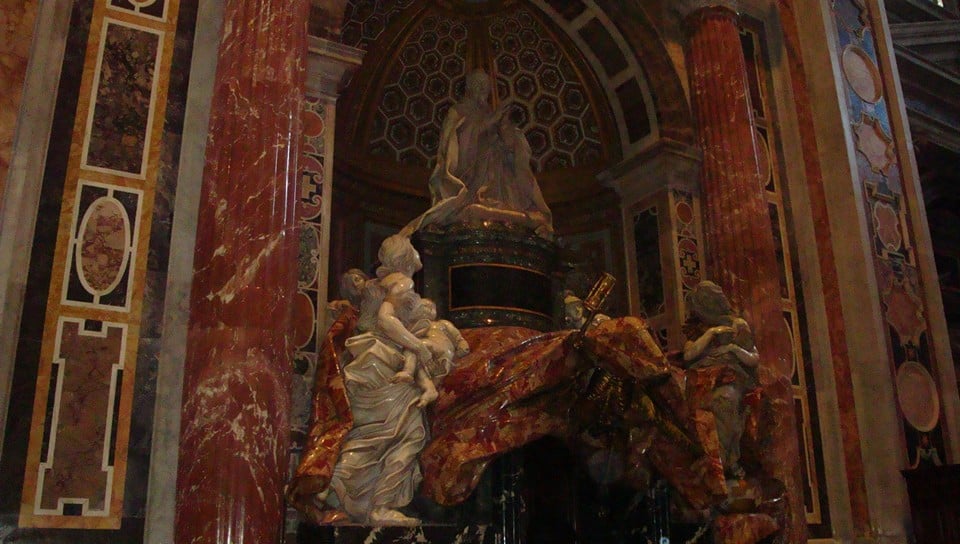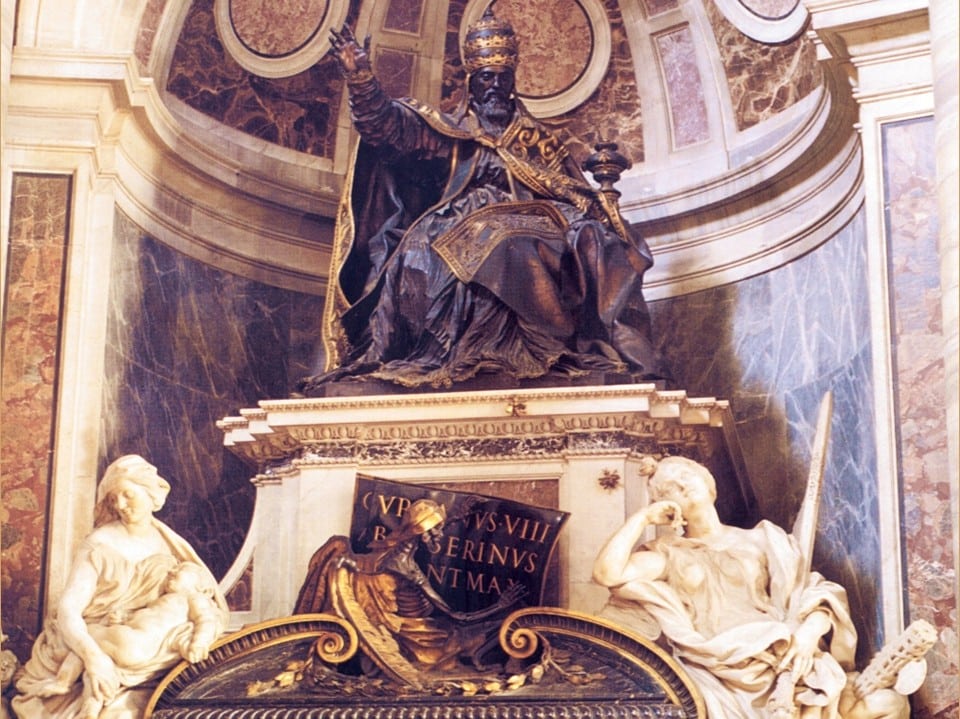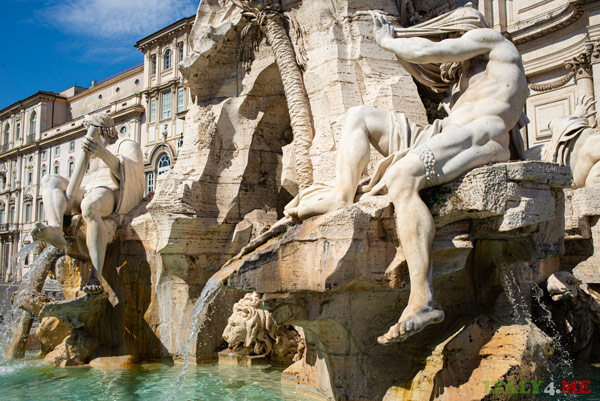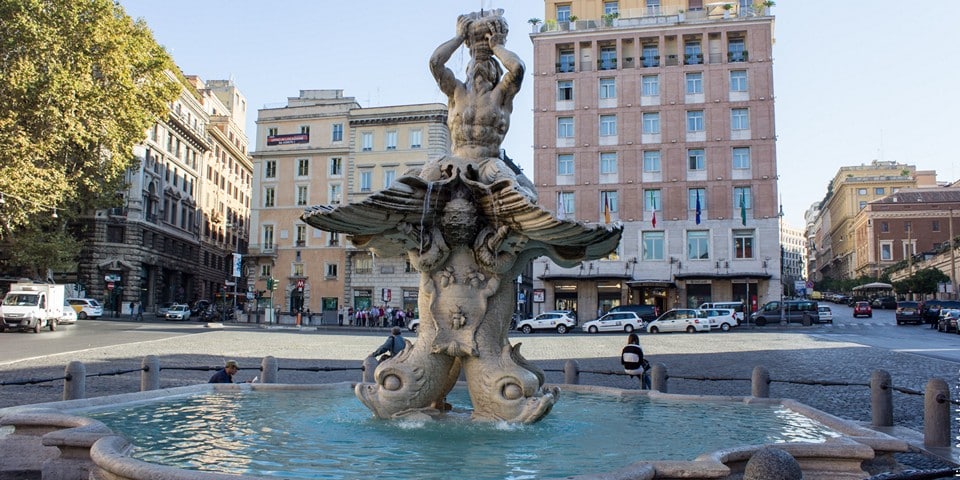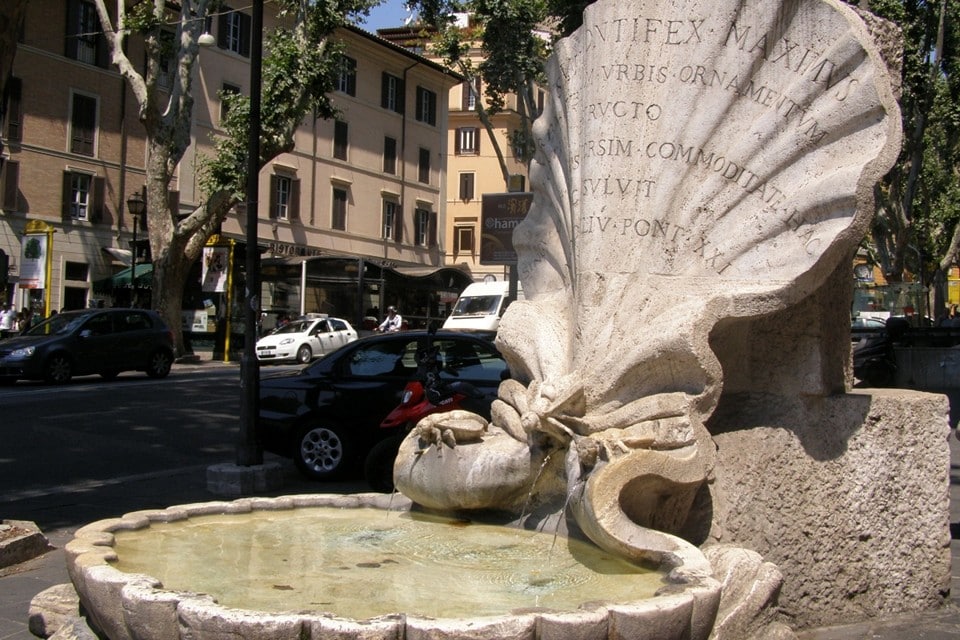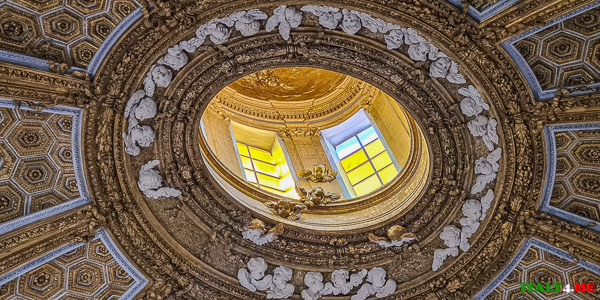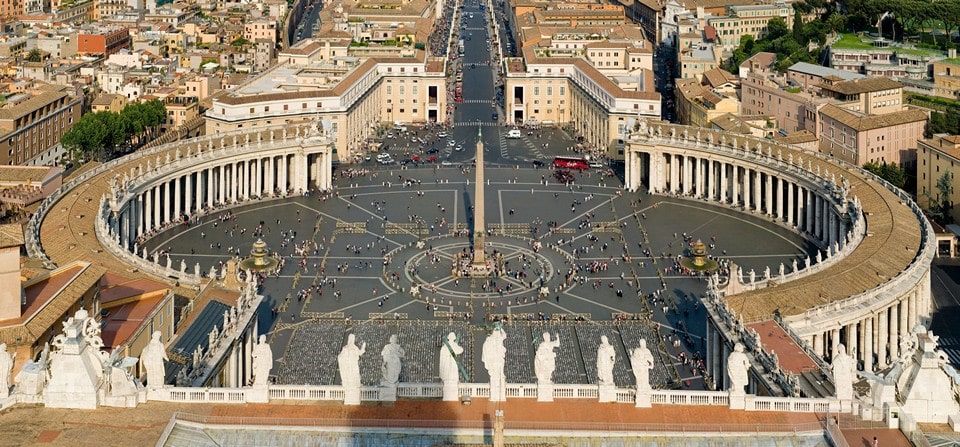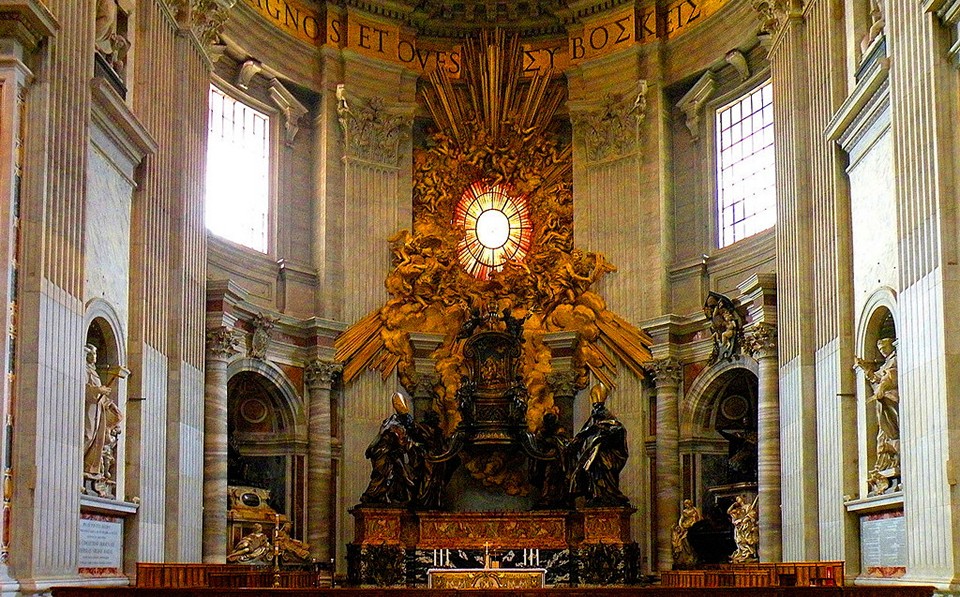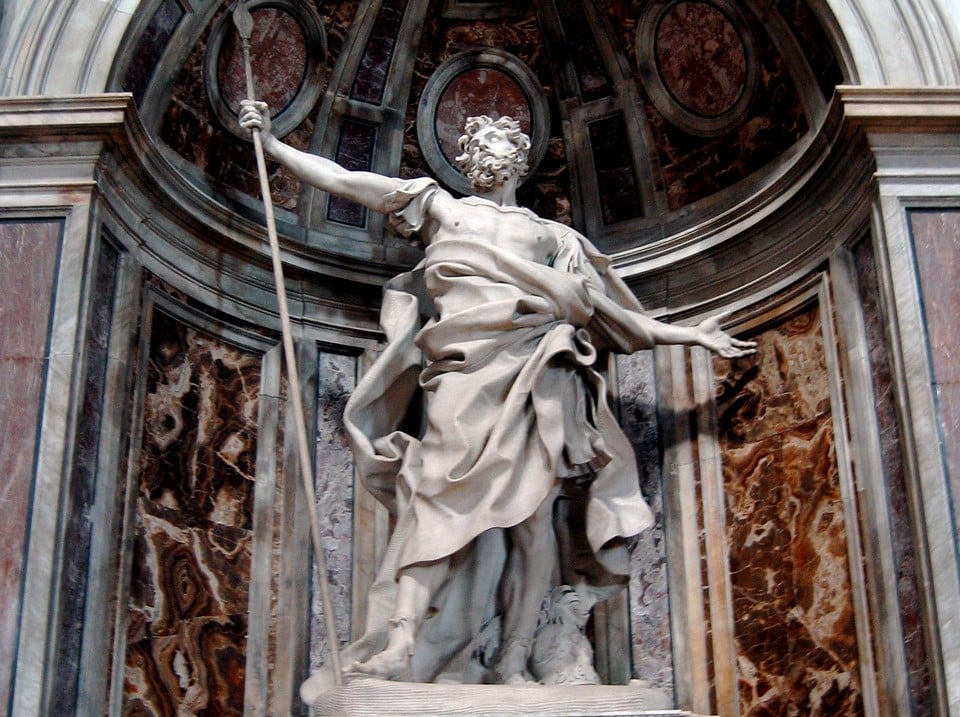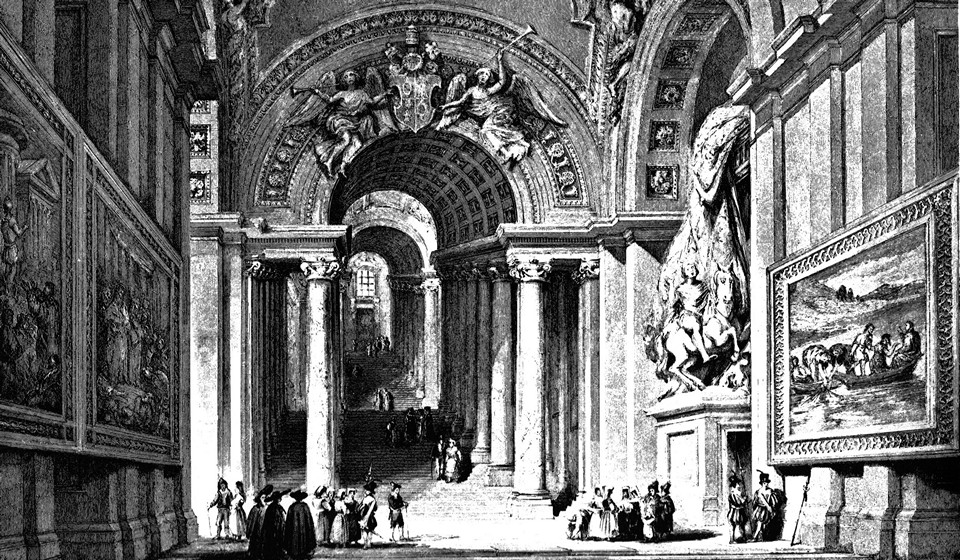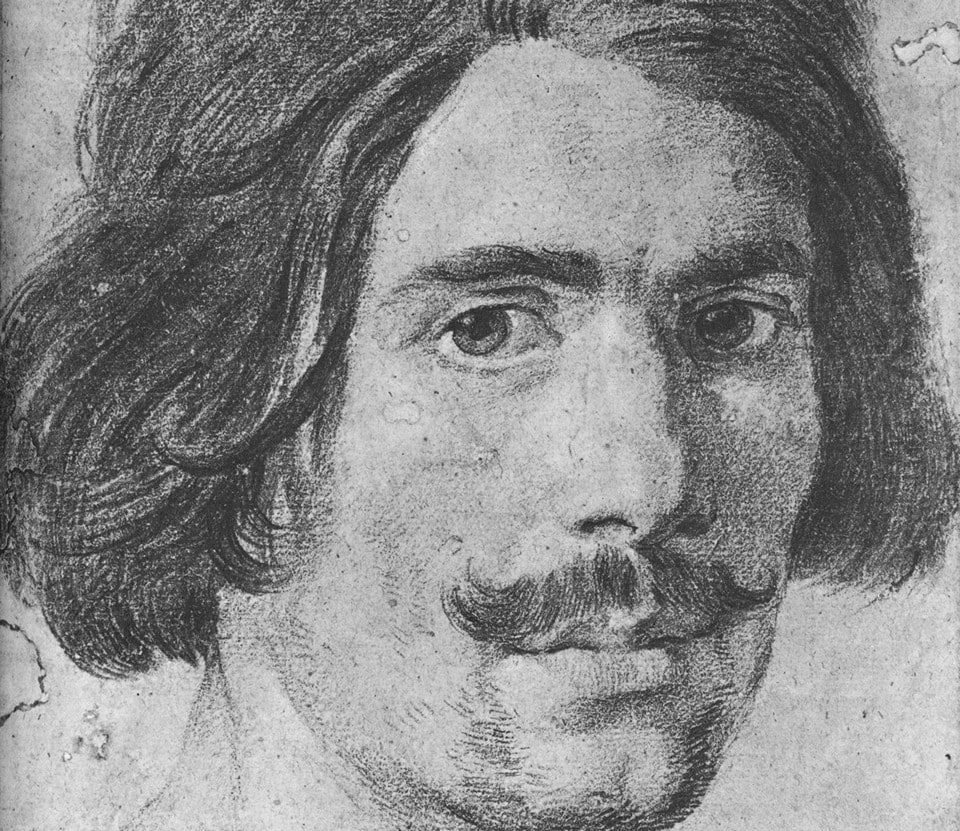Giovanni (Gian) Lorenzo Bernini was an Italian Baroque sculptor, painter, and leading architect of the 17th century.
He was fond of graphic arts, was the first to write cartoons, and was the author and director of forty comedies. He undertook many engineering works for the theatrical stages of the noble and powerful Barberini family.
He created a number of architectural ensembles that became benchmarks of the era. About a hundred of Bernini’s sculptures are recognized as monuments of art. His fountains still amaze by their epicism, grandiose scope, and splendor.
Within the limits of the article, it is impossible to cover all the works of the legendary Italian. Let us dwell on the most important of them.
Page Contents
Biography
Gian, the sixth child of the Bernini family, was born in Naples on December 7th 1598.
Family
The mother, Angelica Galante, was a native of Naples, and the father, Pietro Bernini, was a native of Tuscany. The head of a large family, by the time the heir was born, had already established himself and was making good money. He was a professional sculptor. After Giovanni parents got seven more children.
First works
Since childhood, his father noticed the extraordinary giftedness of his son. The boy loved to draw and always closely watched the work of Pietro. And the latter, with love and great pleasure, engaged in teaching his son.
In 1606, his father took Jan with him to Rome, where he worked on several projects in the papal halls of the Vatican. Thanks to his father, the future master lived in the papal residence for three years. He was surrounded by rare jewels, pilgrims, expensive items, and works of art. The admiration of the child had no limits, all their emotions immediately transferred to paper.
At the same time, Pietro gave the child a chisel and allowed him to help with the details of his sculptures. In the evenings, the father would seek out his son in the halls of the Vatican, calling his name. The boy was praised for his talent and diligence by the artist Annibale Carracci and noticed by Pope Paul V (Cardinal Camillo Borghese). Subsequently, the nephew of Paul V – Cardinal Scipione Borghese (Scipione Borghese) would become the patron of the young Bernini.
The first independent work of 17-year-old Gian was the marble sculpture Amalthea the Goat with the Child Zeus and Satyr. For a long time the author did not reveal his involvement in the work and the sculpture was considered an antique find. Two busts are also known: “The Cursed Soul,” conceived as a self-portrait and “The Blessed Soul,” which the young man made first.
The young sculptor’s work, The Martyrdom of St. Lawrence, is the first step in an attempt to express emotion, tension, passion through the stillness of stone. The first masterpieces drove him crazy with the realism of the images, so well thought out and worked out.
By the age of 22, the young man had already learned a great deal and had become a full-fledged assistant to his father. Paul V, fascinated by the young man’s skill, orders him his own bust. Under the patronage of the Borghese family, Bernini’s talent finds use in the rich villas and gardens of Italian society. He becomes a famous and sought-after sculptor who conquered an entire era.
The cultural legacy left by Giovanni Bernini formed and developed a new direction of art – the Baroque style.
Confrontation with Borromini
Francesco Borromini was an Italian architect from Switzerland.
Borromini was a pseudonym, his real name was Castelli. He was a gifted craftsman and had every reason to be famous, but Bernini’s fame overshadowed his work. With a spiteful, irritable nature, Borromini was always resentful of his rival. The architects had several projects in common. For example, Bernini’s Baldachin in St. Peter’s Cathedral is named after one of them, although they worked in pairs.
Their confrontation became legend. In 1626, Borromini was working on the extension of the palace “de Propaganda Fide” (“de Propaganda Fide”), opposite where Bernini’s house was located. The rivals were not shy about expressing their feelings by depicting various obscene things on the walls of the house and palace intended for each other.
One day Bernini had to build St. Peter’s Church on a swampy area. The architect changed the original plan and built large towers instead of small ones. He was not very experienced in this matter, Borromini could advise many subtleties of construction, but he remained silent. And when the towers began to crack, Borromini insisted on destroying the building, revealing all the mistakes of his rival. Envy of the successes of his competitors led Borromini to suicide.
Sculptures
Bernini’s sculptural masterpieces are unique in that they can reveal to the viewer the finest features of the soul. The master separated passion, anger, desire, and fear from man and encased them in stone, glorifying the Baroque style. A virtuoso of machining marble and bronze, he created imitation of luster on them, gave the effect of soft skin, copied the structure of fabrics.
Bernini’s sculptures are shockingly naturalistic, solemn, and sensual. They seem to be alive, breathing, living, just frozen for a moment. All this was achieved by using special lighting, false perspective, and visual deceptions. To achieve the desired effect, the master used some techniques of elongating the body and depicting gestures.
The ecstasy of St. Teresa
Work on the altarpiece in Carrara marble on a background of color took seven years (from 1645 to 1652) The sculpture is located in the Roman Carmelite church of Santa Maria della Vittoria and is dedicated to a Catholic saint. She recounted that she once saw “an angel in the flesh” and he pierced through her womb with an arrow of gold with fire at the end. At this, the nun felt “the sweet torment of loving God. The gilded rays emanating from above represent divine light.
Apollo and Daphne
The marble sculpture Apollo and Daphne is located in the center of the main hall of the Galleria Borghese in Rome. It was executed from 1622 to 1625.
It depicts Apollo, the sun god, trying to hold on to the nymph Daphne. Apollo was teasing Cupid, and the boy shot an arrow at him, showing his dexterity. The young man saw Daphne first, fell in love with her, and wanted to take her in his arms. Fleeing, the nymph called on her mother, the goddess Gaia, for help. She answered her prayers and turned her daughter into a laurel. Then the lover picked leaves from the tree and wove himself a garland.
Ludovica’s Ecstasy
“The Ecstasy of Blessed Ludovica Albertoni” is the final work of the master. Bernini is now in his 75th year, and the sculpture was a variation of St. Teresa’s Ecstasy. You can see it in Rome, in the church of San Francesco d’ Assisi a Ripa Grande in the Trastevere district. The architect’s fine work is difficult to recreate, even with today’s programmable 3D milling machines. A dying saint lies clothed in religious ecstasy anticipating the coming of the Holy Spirit. White and red marble are used in the work.
David
The sculpture of David is in the Galleria Borghese in Rome. The subject of the brave David is taken by Bernini from an ancient legend. The young man kills the giant Goliath with a stone from a sling. Work on the marble “David” lasted 7 months. The sculpture is saturated with dynamics, tension and hatred of the enemy. When you look at it, you feel the force with which the hero pulls the rope. This distinguishes Bernini’s work from Michelangelo’s David. Michelangelo’s David with its calmness and contemplation.
The Abduction of Proserpine
The marble sculpture The Abduction of Proserpine, 2 meters and 95 centimeters high, was made in one year. It is in the Galleria Borghese in Rome. The plot is from the legend of the daughter of Zeus, Proserpine, and the king of shadows, Pluto. The father gave his daughter in marriage to Pluto, who decided to kidnap her immediately. Helios, the sun god, saw the kidnapping and told Demeter, the girl’s mother. The Goddess of Fertility was enraged with Zeus and became a mere mortal. The thunderer could not allow the absence of life on earth and returned his daughter to her mother. But the cunning husband forced his wife to eat a pomegranate, the symbol of marriage. Now 8 months of the year Proserpine lives with her mother and 4 months with her husband.
Elephant
The life-size marble animal decorates the center of Piazza della Minerva. Opposite the square is the temple of Santa Maria sopra Minerva.
The sculpture was created in 1667 on the basis of eyewitness accounts, as the author himself had never seen a live elephant. The long cover of the animal hides the cube, which was needed to hold the weight of the obelisk. For some resemblance to the pig, the sculpture was nicknamed “Minerva’s pig.” The author was dissatisfied with the work because his sketch was being finalized by church officials. So he turned the elephant’s trunk away from the temple. Read more about Bernini’s elephant.
The Prophet Abbacoum
The sculpture “Abbacoum and the Angel” is in the Roman church of Santa Maria del Popolo in the Capella Chigi. The prophet gazes in wonder at the angel who has descended to him. The angel is going to carry Abbukum by the hair of a thousand kilometers into a moat with lions to the prophet Daniel, so that the latter would eat food from his native land. Created in 1665.
The Truth
The Truth sculpture was 2 meters and 80 centimeters high and was created in 1646-52. It is a girl on a rock with the sun in her right hand and a globe under her left foot. It was created after the tragedy with the construction of St Peter’s Church and remained unfinished. Next to it should have stood Time. It is considered an unsuccessful work of the master. Can be viewed in the Galleria Borghese.
See instructions: how to buy tickets to the Galleria Borghese on your own
Saint Bibiana
The sculpture was created in 1626 for the Roman church of St. Bibiana (Santa Bibiana), Bernini’s first architectural project. Behind the church is the temple of Minerva Medica. Saint Bibiana was condemned to death by the Emperor Julian the Apostate and taken next to one of the columns of the church. The author depicted her with a palm leaf, the symbol of the martyrs. The burial of the saint is carried out here as well.
Neptune and Triton
The marble work, 1 meter 82 centimeters high, can be seen in London’s Victoria and Albert Museum. Bernini worked on it from 1620 to 1624. A scene from the epic Aeneid by Virgil (Vergilius). Neptune ensures Aeneas’ safe passage across the sea by taming the waves. And Triton, son of the sea god, trumpets the horn. When the sculpture stood at the Villa Peretti Montalto as a fountain, a stream of water gushed from the horn.
Bacchanalia
The marble sculpture “Bacchanalia. Children Teasing Faun” is in New York at The Metropolitan Museum of Art, New York. The master worked on it from 1616 to 1617. With his absolute authority, he glorified church dogma and at the same time corrupted it. The religious statue appeared in light of scandal and passion.
Medusa’s Head
The sculpture is rightly considered a jewel of Italian Baroque. It has belonged to the Musei Capitolini in Rome since 1731. However, it is not mentioned in the biographies of Domenico Bernini and Filippo Baldinucci. One of the sculptor’s researchers, Rudolf Wittkower, was the first to suggest that Bernini was the author of the Head of the Medusa.
Aeneas, Anchises, and Ascanius running from Troy
The 20-year-old sculptor’s subject is again inspired by Virgil’s Aeneid. Anchises and Aphrodite had a son, Aeneas, and a grandson, Ascanias. When Troy was engulfed in flames, the gods ordered them to flee. The fugitives escaped and wandered for a long time until Aeneas founded a city in Latium, Rome. From Ascanius came the dynasty of the Julii (Caius Iulius Caesar, Octavianus Augustus, etc.). The sculptural monument belongs to the Galleria Borghese.
Putto with the dragon
The sculpture is a collaboration between Gian and Pietro Bernini and was made for Maffeo Barberini in 1617 (before he became Urban VIII). Perhaps it was meant to be part of a fountain, as the dragon has a hole in its mouth. It shows the little Hercules ripping the dragon’s mouth open with his hands, as the legends tell of the hero’s incredible strength from birth. According to one version, the mythological animal represents the symbol of the coat of arms of Scipione Borghese.
Cursed Soul
Considered a marble self-portrait of the author and the opposite of the Blessed Soul sculpture. Located in the Palzzo Monaldeschi. Another sculptor, a fan of Bernini’s work, Massimiliano Soldani-Benzi reproduced a copy in bronze around 1707.
Saint Lawrence on the Grille
The saint was sentenced to be burned alive on an iron lattice. Among Christians he is, oddly enough, the patron saint of cooks. When one side of the body was already burnt, the martyr turned to the executioners and told them to turn himself over. The work was made in 1617 and is in the Galleria degli Uffizi in Florence.
Read about How to get to Florence from Rome
Saint Jerome and Mary Magdalene
The statues of Maria Magdalena and Hieronymus are in the Capella della Madonna del Voto, also designed by Bernini. It is the Chapel of the Cathedral of Siena (Duomo di Siena), a monument of Italian Gothicism and the main church of Siena (Siena). The Madonna is considered the guardian of the city.
Savior of the World
The sculpture “Savior of the World” is made of bronze in the form of a bust. The author finished it in 1679, almost before his death. It was intended for Queen Christina of Sweden (Kristina av Sverige), and it was not possible to identify the sculpture until 2001. It is kept in the Basilica di San Sebastiano fuori le mura, outside the walls of Rome.
Busts
In addition to the life-size sculptures, Bernini’s works include several busts of prominent figures. It was considered prestigious to capture one’s own image with the great master.
Bust of Shipione Borghese
The bust of the first patron was made by the master in 1632 and is in the Galleria Borghese. It is one of Bernini’s earliest works and is considered a masterpiece of lively naturalness. The folds of the garment look as if they have just been assembled. The contour lines of the face are not perfect in their relief. There were a total of two of these busts. The first turned out to have a slight marble defect in the forehead area. And in 15 days, to please the Cardinal, Bernini made a second one of the same kind, but without flaws.
Bust of Cardinal Richelieu
A 1641 marble bust of Armand-Jean du Plessis, duc de Richelieu, is now in the Musée du Louvre in Paris. The Cardinal himself was very pleased with it and paid it his most attentive tribute.
Bust of Thomas Baker
This marble portrait was made in 1638 and today belongs to the Victoria and Albert Museum in London. The museum bought the bust in 1921 for 1480 guineas. Baker was sheriff of the East Suffolk county of England and served the court of Charles I Stuart.
Bust of Constanza Buonarelli
Constanţa Bonarelli was a lover of Bernini, but cheated on the sculptor with his younger brother Luigi. Giovanni set a trap for them and beat his brother with an iron rod. And his servant mutilated the girl’s face.
Later the traitor was banished from the city and the traitor imprisoned. Bernini was defended by Urbanus PP. VIII. The work, executed in 1634, is in the Museo Nazionale del Bargello in Florence.
Bust of Alexander (Alexander PP. VII)
The bust of Pope Alexander VII in marble and gilded bronze was in work from 1655 to 1667. Another patriarch of the Vatican was a patron of the master, and subsequently, Bernini’s work was also used to decorate Alexander VII’s tombstone. The sculpture is in the Palazzo Chigi Zondadari in Siena.
Tombstones and monuments
Bernini embodied in stone not only mythical, divine and royal figures. Some were honored by the great master even after his death.
Tombstone of Pope Alexander VII
Located in the Basilica di San Pietro, where the pope is buried. A stunning sculptural composition that makes an indelible impression. Work on it was completed in 1678. It stands out against the background of the general pomp of the cathedral’s decoration by its scale. Students of the master made statues of Justice, Prudence, Truth and Mercy. Bernini himself took no part in the work, apart from accepting the commission and remuneration, preparing the designs and supervising the work of the sculptors.
Monument to the nun Maria Raggi
The memorial is in marble and gilded bronze and was erected in 1647 on a column in the church of Santa Maria sopra Minerva in Rome. Mary was a nun from the island of Hios. Early in her widowhood, she prayed a lot and was able to perform miracles. Three of Maria’s descendants were responsible for commissioning Bernini’s work: Tommaso, Lorenzo and Ottaviano. Their names are inscribed at the bottom of the memorial.
Tombstone of Countess Matilde di Canossa
The work was erected with her students. She was the first woman to be buried in St. Peter’s Cathedral. In her ancestral castle, Pope Gregory VII (Gregorius PP. VII) hid from the French King Henry IV (Henri IV). When the monarch was deposed and excommunicated, he came to beg the pope for forgiveness in 1077. The tombstone was commissioned by Urban VIII in 1633. The following year the body of the countess was transported from Mantova to the tombstone that was erected.
Tomb of Pope Urban VIII
The tomb of Pope Urban VIII was created by Bernini along the lines of the baroque tomb in Saint Peter’s Basilica. Urban VIII continued the construction of the basilica begun by Julius II (Iulius PP. II). He also employed Bernini, who identified a place for the pope’s tomb on the north side of the cathedral. At the center of the composition sits the Pope, dispensing blessings. On either side of him are the figures of Justice and Mercy. At the feet of the Pope, between the figures, death records the name of Urban VIII in the Book of Eternal Remembrance.
Fountains
Bernini’s fountains are grand and majestic architectural structures with a storyline.
The Fountain of Four Rivers
The Four Rivers Fountain (Fontana dei Quattro Fiumi) was built according to a design by Bernini from 1648 to 1651. It is located in Piazza Navona in front of the Palazzo Pamphilj. The client was Pope Innocentius PP X. At the heart of the square is an obelisk with statues around it. The statues symbolize the four rivers of the world: Nile, Danube, Ganges and La Plata.
Fountain of Triton
The Fontana del Tritone was built on Piazza Barberini, in front of Palazzo Barberini, at the request of Urban VIII, just after the palace was finished.
On a pedestal of four dolphins, arranged with their tails upwards, is a large shell with open flaps. On them sits the figure of Triton, and between the dolphins is the coat of arms of Barberini.
The Fountain of Bees
The Fountain of the Bees (Fontana delle Api) is on the corner of Piazza Barberini and Via Vittorio Veneto. It was finished in 1644, in the form of an open shell, one flap filled with water. On the other is engraved the name of Urban VIII. In the middle of the flaps are three bees, symbols of papal authority.
Bernini’s original inscription read: “Urban VIII built this fountain …in 1644, in his XXII year on the papal throne,” although it was still a couple of months away from his 22nd year. The townspeople were outraged that Barberini was trying to take his time and the pope’s nephew ordered one unit removed at the end. Urban VIII died nine days before his 22nd year of reign.
Architecture
Bernini’s architectural structures were subject to the same style in which all of the sculptor’s other works were created.
Church of Sant’Andrea al Quirinale
The church of Sant’Andrea al Quirinale was built for the Italian royal house according to Bernini’s designs from 1658 to 1678. The architect made it oval, placing inside eight diverse chapels. The main colors of the building were gray, white, pink and gold. The construction was ordered by Camillo Pamphilj, nephew of Innocentius PP X.
The Cornaro Chapel in the Cathedral of Santa Maria della Vittoria
Cornaro’s Chapel in the Cathedral of Santa Maria della Vittoria in the west wing of the small titular church in the east of Rome stands out for its theatrical decoration and richness. It is here that the sculptor’s favorite altarpiece, The Ecstasy of St. Teresa, is located. The marble-framed chapel of funeral chapel was commissioned by the patriarch of Venice, Cardinal Federico Cornaro. On either side of the altar, members of the Cornaro family are seated on balconies, discussing the vision of the saint.
Works at the Vatican
In addition to the tombstones of Countess Matilda of Canossa, Pope Alexander VII, and Pope Urban VIII, the Vatican has a huge legacy of Bernini’s work.
Colonnades in St. Peter’s Square
The construction of the square lasted 11 years, it was finished in 1667. On both sides of the square there are collonades as a symbol of the church arms embracing the earth. The columns, 20 meters high and 1.6 meters wide, were installed in four rows. There are 284 columns in all, 140 of them are decorated with statues of religious figures placed on top. On the right and left sides of the main obelisk of the square there are plates of marble, standing on which you can see only 1 row of columns. Bernini knew geometry well.
Baldachin
The baldachin (ciborium) is located under the dome above the main altar (in the mediocre). The height of the ciborium on 4 twisted columns, repeating the models of the columns of the Temple of Solomon (Salomon), is 29 meters. On the crests of the laurel at the top of the columns are coats of arms Barberini bees. It took about 45 tons of bronze for the ciborium. At first the material was taken from the cathedral dome, then it was brought from Venice (Venezia) and Livorno (Livorno). But when that wasn’t enough, the support for the roof of the Pantheon portico was dismantled.
The pulpit of the Apostle Peter
Alexander VII realized the bronze basilica of the Cathedral of S. Petri Apostoli between 1656 and 1665 and was designed for the chancel of St. Peter’s Basilica. The jewel of the pulpit is the wooden throne belonging to the Apostle Peter. The relic was given to Pope John VIII by Charles le Chauve in 875. At first, the throne was hidden from view, but in 1867 it was put on display. Around the throne are the figures of the angels, supported by Ambrosius Mediolanensis, with Aurelius Augustinus in the first row, and John Chrysostom with Athanasius the Great in the second. The pulpit is recognized as the top of the sculptor’s skill.
Equestrian statue of Constantine
The equestrian statue of Constantine the Great – the sculpture was created from 1654 to 1670 and was commissioned by Innocent X. When Clement X came to power, he erected the statue in front of the staircase of the papal palace. Constantine (Constantinus) the Great, before the battle with Maxentius (Maxentius), saw a symbol of a cross and the inscription on the ground: “Thou shalt overcome”. The commander and his soldiers were frightened by what they saw, but at night Constantine received a dream from Christ, which led him to sew a banner to match the symbol he had seen that day. The king obeyed the vision and the army defeated the enemy. The statue is now in St. Peter’s Cathedral.
Saint Longinus
The sculpture of Saint Longinus, more than 4 meters high, was made in 1638 and is installed in St. Peter’s Cathedral. Longinus is the Roman warrior who pierced the crucified Jesus with his spear. Realizing that Christ was God’s son, the warrior became a Christian. The Fogg Museum at Harvard has a small terracotta model of the sculpture, made by Bernini before creating the main work. But the final version differs from the original, as the altered design of the cathedral canopy led to changes in the sculpture of Longinus. As a result, Longinus is depicted facing the god with his spear retracted and his armor at his feet.
Altarpiece of the Chapel of the Holy Communion
One of the best chapels of St. Peter’s Cathedral is not for tourists. Only those who want to pray can get in here. It was built especially for Urban VIII, as evidenced by the bees from the Barberini coat of arms present in the decoration. Rare marble was used for the altar’s incredible beauty. Above the altar is a monstrance of gold, silver and blue glaze. On either side of it are two bronze angels, covered with gilt.
Sovereign’s Staircase
“The Rock of Regia,” the grand Royal Staircase, is the main staircase in the Vatican. It connects the papal palace and St. Peter’s Cathedral. The staircase was created using artificial perspective in 1666. The lower flights of stairs, narrowing, go straight, being the continuation of the right corridor of St. Peter’s Square. Then it turns 1800 and the last flight, not visible from below, goes back down. Thanks to the altered illusory perception and the particularly positioned lighting, the figure of the pope emerging from the palace appears larger.
Paintings
Bernini painted many self-portraits and several paintings that have survived to this day. Critics believe that Bernini the painter is inferior to Bernini the sculptor, but today his canvases occupy worthy places in the collections of galleries and museums. Some of the works are:
- Portrait of a Young Man (Self-Portrait), 1615 (chalk, Horne Museum in Florence);
- Saint Andrew and Saint Thomas, 1617 (oil on canvas, National Gallery, London);
- Self-Portrait as a Young Man, 1623 (oil on canvas, Borghese Gallery);
- David with the Head of Goliath, 1625 (oil on canvas, Roman National Gallery of Ancient Art);
- Portrait of a Man with a Mustache, 1630 (lead whitewash and chalk, The Royal Collection of Her Majesty Queen Elizabeth II);
- Portrait of Pope Urban III, 1632 (oil on canvas, Galleria Nazionale d’Arte Antica, Rome);
- Self-Portrait in Maturity, 1630-1635 (oil on canvas, Galleria Borghese);
- Portrait of a Boy, 1638 (oil, Galerie Borghese).
Hotel
Hotel Sina Bernini Bristol is a 127-room 5-star hotel located in an exclusive area of Rome, on Piazza Barberini. The hotel offers excellent views of the historic center of the city. It was built in 1874 and is decorated in an ancient style.
Advice:
- Best 5-star hotels in Rome
- How to get a cheap apartment in Rome
Private Life and Death
After an unsuccessful affair with the wife of his assistant Constance Bernini, by order of Pope Urban III, he married the 22-year-old Catherine Tercio (Katerina Tercio). The girl was the daughter of a notary from Rome and subsequently gave her husband 11 children. His son Domenico was the first to write a biography of his father.
Bernini died in 1680, surviving eight popes. He was buried in the Basilica di S.Maria Maggiore with his parents.
Interesting Facts
- “Graziano: – Who is this Graziano? Graziano: – Who is he? He is the very plot of our comedy! Tratian:- Oh yes! But if the world is nothing but a comedy, then Gracian is in the plot of the universe!” These words are from an unfinished comedy by Bernini, which is in the Bibliothèque Nationale de France;
- Paul V was the first to compare the talent of the young Gian to that of Michelangelo when he presented him to the future Pope Urban VIII;
- Gregorius PP. XV bestowed a knighthood on Bernini;
- King Charles I of England, wishing to be immortalized in a bust by Bernini, sent him three portraits. When Queen Christina of Sweden visited the sculptor in his studio, he came out to her in work clothes. The monarch was not in the least offended, touching the robe as if it were an exhibit;
- Dan Brown wrote the novel Angels and Demons in 2000, in which Bernini is a member of a secret organization.
 Italy for me From Italy with love
Italy for me From Italy with love

